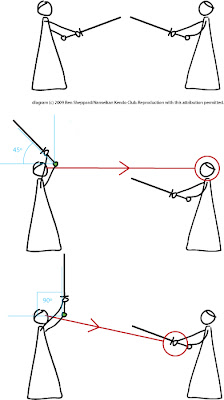Cross-training for kendo
.jpg) Caleb running up Tiger Head Mountain in Taiwan.
Caleb running up Tiger Head Mountain in Taiwan.Why am I running up and down a mountain in that photo? (I usually go up and down five times each way, plus I have to hike to and from those stairs.) Check out this article on cross-training:
http://www.runnersworld.com/article/0,7120,s6-238-263--7420-1-1-2,00.html
There are three main reasons I cross-train:
1. The first won’t really apply to you, but because I’m older I have to vary my training so I won’t get worn out and/or injured so readily from doing the same thing over and over. Physically, I simply couldn’t do kendo every day.
By hiking, mountain-biking/cycling, surfing and working out, I’m able to exercise every day (actually more than once per day sometimes), and thus, attain a level of fitness that would be impossible if I only did kendo. To give you an indication of this, between a better diet and more exercise, I’ve lost more than seventeen kilos in the past eleven months in Taiwan and I can out-last most of my friends ten years younger than me on a big hike. A few months ago, one of my best friends here (who is fairly fit) and I hiked up to a temple on the outskirts of Taipei. We wanted to see how long it would take us to get to the top of the 1,200 stairs. Time: 14 minutes. That’s 1.43 steps per second. I don’t work out in the conventional sense (with metal weights), but instead, I go for really short, intense training sessions that will build practical fitness (as opposed to gym strength), and really get me huffing and puffing (which mimics what you’d need for kakari-geiko, for instance). Check out these videos:
http://tw.youtube.com/watch?v=6yboEs7w5F0 (That guy has a lot of great videos.)
http://tw.youtube.com/watch?v=eDh1Cspl0jI
2. I’ve been dealing with a really annoying thumb/wrist injury for the past few months. Again, if I only did kendo, I simply wouldn’t be able to do kendo because the weakest link would prevent me. As it is, I’m able to hold off on going like a bull at a gate a bit at kendo and be more sensible in my training, and work on my fitness in other ways. If I get an injury in one part of my body, I can change the emphasis of my training. Shoulder injury? Do more hiking or cycling. Ankle injury? More upper-body and core work.
3. Finally, motivation is a big factor for me. I’m someone who gets bored doing too much of the same thing. I simply couldn’t do kendo every day from a psychological point of view. By doing a lot of other things, I manage to keep myself really fresh mentally, and my enthusiasm for kendo is sky-high right now. It also means that if I’m going through a bit of a rut with my kendo, I don’t feel like everything really sucks. It’s hard to feel that way when you’re on top of a mountain, or speeding down it on your bike, or catching a wave. A lot of the time, cross-training doesn’t even feel like training (even if your lungs say otherwise!) because it’s so much fun.
Of course, one final factor, which is probably most relevant to most of you kids, is accessibility of training. Maybe your parents don’t have time to drive you around to a whole bunch of different kendo dojos all over Melbourne. That doesn’t mean you can’t get on your bike or play soccer with your friends in the park. That’s cross-training too. Be imaginative. If you can’t train for kendo for some reason, such as being on holidays, it doesn’t mean you can’t become a super fitness beast by running up and down the local hill and freak everyone out with how hard you can go the next time you do kakari-geiko. Everyone else will be thinking, “Gee man, I just want to get through the next kiri-kaeshi, but look at this guy!”
Caleb

Comments